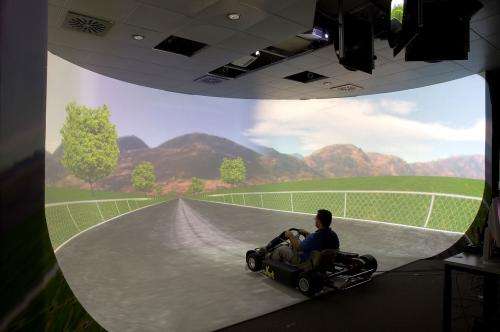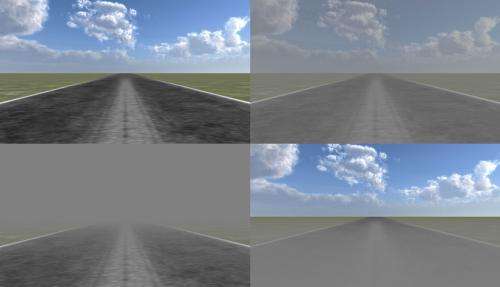Foggy perception slows us down

Fog is an atmospheric phenomenon that afflicts millions of drivers every day, impairing visibility and increasing the risk of an accident. The ways people respond to conditions of reduced visibility is a central topic in vision research. It has been shown that people tend to underestimate speeds when visibility is reduced equally at all distances, as for example, when driving with a uniformly fogged windshield. But what happens when the visibility decreases as you look further into the distance, as happens when driving in true fog? New research by Paolo Pretto at the Max Planck Institute for Biological Cybernetics in Tübingen published in eLife, reveals that people tend to overestimate their speed when driving in fog-like conditions and therefore naturally tend to drive at a slower pace.
Poor visibility conditions affect millions of drivers around the world. Thousands of them die each year in a car accident. Excessive speed constitutes a major causal factor for these car accidents. For the first time Paolo Pretto and his fellow scientists, in the department for Human Perception, Cognition and Action of Heinrich Bülthoff at the Max Planck Institute for Biological Cybernetics in Tübingen, Germany, showed how fog biases speed perception and revealed the perceptual mechanisms underlying this bias, providing important insights into the human visual system. In particular, they showed that contrarily to what was previously believed, speed is overestimated in fog, because visibility is poorer in the central than in the peripheral area of the visual field. The researchers also show that the behavioural consequence of this speed overestimation is a natural tendency to drive at a slower pace.

Using a new approach Paolo Pretto and his colleagues performed a series of experiments involving experienced drivers and high-quality virtual reality simulations. "We have shown that speed can also be overestimated at a low contrast of the surrounding scenery when driving a car", explains the psychologist. "This occurs notably when contrast is not reduced uniformly for all objects of the visual scene, but proportionally to their distance from the viewer, as is the case in fog." In one experiment drivers were presented with two different driving scenes and asked to guess which scene was moving faster. In the reference scene the car was driving at a fixed speed through a landscape under conditions of clear visibility. In the test scene it was moving through the same landscape, again at a fixed speed, but with the visibility reduced in various ways.
The experiments showed that drivers overestimated speeds in fog-like conditions, and underestimated them when the reduction in visibility did not depend on distance. Further experiments confirmed that these perceptions had an influence on driving behaviour: drivers recorded an average speed of 85 kilometres per hour when the visibility was good. This dropped to 70 kilometres per hour in severe fog. However, when visibility was reduced equally at all distances like in a fogged windshield instead of fogged surroundings, the average driving speed increased to 100 kilometres per hour.
Based on previous work, the scientists developed the theory that the perception of speed is influenced by the relative speeds of the visible regions in the scene. When looking directly into the fog, visibility is strongly reduced in the distant regions, where the relative motion is slow. Yet, it is preserved in the near regions, where the motion is fast. This visibility gradient would lead to speed overestimation. To test this theory, they repeated their experiments with new drivers under three different conditions: good visibility, fog, and an artificial situation called "anti-fog" in which visibility is poor in the near regions and improves as you look further into the distance. As predicted, the estimated speed was lower in anti-fog than in clear visibility and fog.
Conversely, the driving speed was 100 kilometres per hour in anti-fog, compared with 70 kilometres per hour in good visibility and 50 kilometres per hour in fog.
Overall the results show that the perception of speed is influenced by spatial variations in visibility, and they strongly suggest that this is due to the relative speed contrast between the visible and covert areas within the scene. Therefore, drivers should better listen to their visual system when it prompts them to decelerate in foggy weather.
More information: Pretto P., Bresciani J.-P., Rainer G., Bülthoff H. H. (2012) Foggy perception slows us down. eLife. doi: 10.7554/eLife.00031.001


















